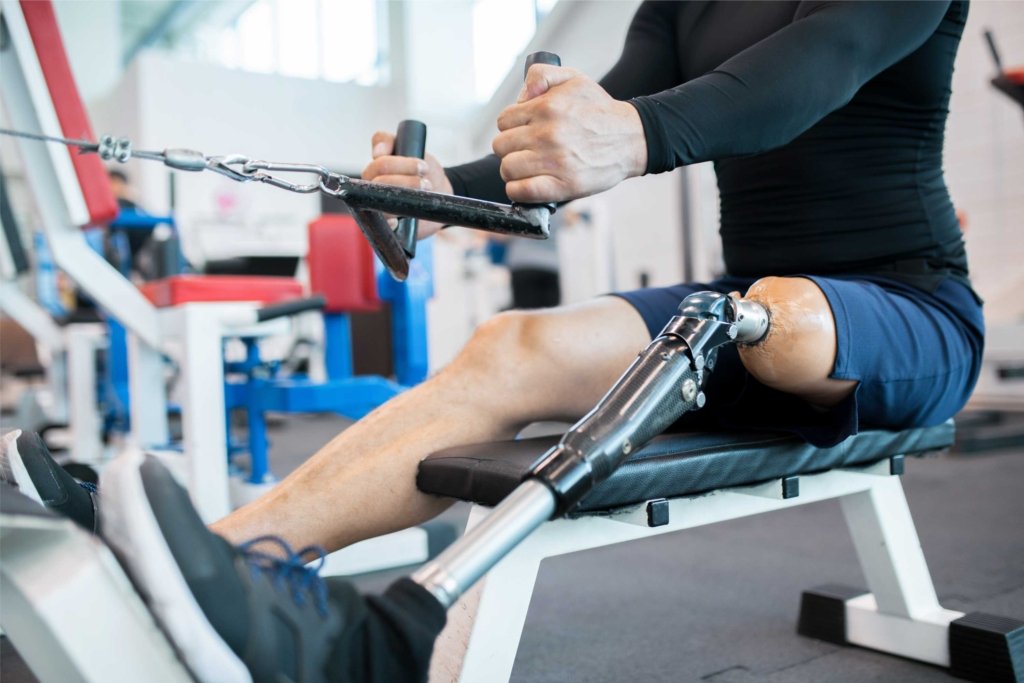Everything You Need to Know About Osseointegration

What is Osseointegration?
Osseointegration is the medical term used to describe bone growing into a metal (usually titanium) implant. Osseointegration has successfully been used for decades in dentistry (for dental implants) and joint replacement surgeries, however, it has only recently been used in amputation surgery with remarkable results. In Osseointegration limb replacement surgery, a titanium prosthesis is directly connected to the skeleton, and is aligned with the residual limb.
How was Osseointegration discovered?
Osseointegration was first used in clinical practice in 1965, with Professor Per-Ingvar Branemark who successfully inserted titanium implants into the upper and lower jaw as anchor points for dental implants. Whilst it became well accepted technique in dentistry soon after the initial implementation in 1965, it’s first use in an amputee took place in 1990 where prof Brånemark’s son inserted the first transcutaneous femoral intra-medullary prosthesis in a patient with an above knee amputation.
In which types of amputation can osseointegration be used?
Osseointegration limb replacement surgery can be performed in the following bones:
- the femur (thighbone)
- tibia (leg bone)
- humerus (upper arm bone)
- radius and ulna (forearm bones)
What are problems that patients with socket prostheses face?
With traditional socket prostheses, some patients have a poor fit between their residual limb and the prostheses, despite multiple adjustments. This is because there can be significant changes in the size and shape of their stump in the first 24 months after amputation.
The most commonly reported problems with standard socket type prosthesis are:
- heat or sweating in the prosthetic socket
- sores or skin irritation from the socket
- inability to walk in woods and open fields
- inability to walk quickly
- pain in the residual limb.
As a direct consequence of the above problems, certain amputees cannot use their prostheses more than a few hours per day and quite often not even on a daily basis.
Apart from physical problems with the socket type prostheses, which are related in majority of the cases to socket-skin interface, people will also notice:
- Slower walking pace and
- Increased tiredness.
Both consequences are a direct consequence of increased energy consumption (oxygen consumption) which is very likely directly related to the level of amputation in the lower limb.
The increase in energy consumption that amputee patients experience above non-amputees can be found in the table below.
How can osseointegration solve the issues patients with socket prostheses face?
In a standard socket prosthesis, force to the prosthesis is delivered from the muscles, which move the bone stump. During movement, the soft tissue in the stump (i.e. muscles, subcutaneous fat and skin) are compressed against the prosthesis socket. This can cause significant pain, discomfort and swelling over time for amputee patients.
In osseointegration, the bone stump is directly connected to the prosthesis with no “slack” in the system. Muscles are moving the bone stump together with the metal stem inserted. This avoids the need to compress the soft tissue inside a socket prosthesis as before, making it a more efficient mode of travel. There is no socket required for the prosthesis to be attached to removing all socket related problems (heat or sweating in the prosthetic socket, sores or skin irritation from the socket, inability to walk in woods and open fields) completely.
What are the advantages of osseointegration over traditional socket prostheses?
Patients who undergo osseointegration surgery report the following advantages over patients with socket prostheses:
- Improvement in movement and mobility of the prosthetic limb
- Improvement in control of the prosthetic limb
- Reduction in phantom limb / nerve pain
- Reduced soft tissue and skin related irritation from the socket prosthesis
Who is suitable for osseointegration surgery?
Patient having problems with conventional socket prostheses like:
- Discomfort, pain, poor suspension, or an inability to use conventional socket prostheses at all
- Recurrent skin infections and ulceration, a short stump, soft-tissue scarring, volume fluctuation of the stump, extensive areas of skin grafting, socket retention problems due to excessive perspiration
- Expected to have problems with conventional prosthesis
- Have reached full skeletal maturity (i.e. not suitable for children)
- Normal skeletal anatomy
- Age criteria: Between 18 and 70 years old
- Are suitable for surgical procedure on the basis of medical history and physical examination (i.e. don’t have significant other medical conditions)
- Agree to comply with the treatment program and follow-up.
Who is not suitable for osseointegration surgery?
Patients with the following conditions MAY not be suitable for osseointegration surgery. We recommend arranging a consultation to discuss whether or not you are suitable. These conditions include:
- Severe peripheral vascular disease
- Diabetes
- Current chemotherapy treatment, corticosteroid use, or immunosuppressant drugs
- Limb exposure to radiation
- Pregnancy
- Mental illness or disabling psychiatric disorder
- Heavy smoking history (patients are encouraged to quit or decrease)
- Osteoporosis, atrophic bone conditions
- Body weight in excess of 100 kg
- Infection, not further specified
- Skin disease involving the amputated limb
- Noncompliant during preoperative screening and evaluation
- Patients who are satisfied with conventional socket technology (obviously would not benefit from further surgery in this case).
Who is involved in looking after me before, during and after osseointegration surgery?
Every patient who undergoes Osseointegration surgery is looked after by a multidisciplinary team of healthcare professionals. Each member of the team is essential in looking after different aspects of care for the patient. The team includes:
- Orthopaedic surgeons
- Anaesthatists
- Nurses
- Orthotists
- Physiotherapists
- Occupational therapists
What are the risks involved in Osseointegration surgery?
Osseointegration surgery is very safe, however like all surgery it is important to be aware of the possible complications. The main complications related to osseointegration procedure are:
- Infection (deep and superficial)
- Periprosthetic fracture
- Aseptic loosening
Superficial infection:
Many patients who undergo osseointegration will experience superficial infections which can present with pain, redness, swelling and discharge from around the stoma. These are referred to as ‘superficial’ as they only involve the skin and subcutaneous tissues and the bacterial has not penetrated deeper inside the limb. Depending on the severity of the infection and type of bacteria involved, this infection will be treated with oral or intravenous antibiotics.
It is well accepted that superficial infection rate is 100%, meaning that it is extremely likely that every patient will experience this complication at least once, therefore every single patient has to be aware of it but also be able to recognise early signs and react upon them as soon as possible. Even a few hours delay can result in prolonged treatment and increased pain.
Deep infections:
Deep infections are not as common. Deep infections are ones which have penetrated deeper into the limb and can involve the bone and prosthesis. Around 20% of patients will experience deep infection/osteomyelitis (infection of the bone) in the first 10 years post osseointegration. Almost half of them (9% of all patients) will need their implant removed and be treated for osteomyelitis. If the osteomyelitis is successfully treated, the stem can be reinserted.
Periprosthetic fractures:
Periprosthetic fractures, or fractures in the bone around the prosthetic, can happen during the insertion of the implant into the bone during surgery or can happen at a later stage, mainly as a result of a fall or any other traumatic incident. The incidence of periprosthetic fractures is between 10-25%. The fractures are treated using standard implants for bone fracture fixation, only in specific cases, custom made implants have to be used.
Aseptic loosening:
Aseptic loosening is when there is the failure of the bond between an implant and bone in the absence of infection. Aseptic loosening is a complication in many forms of orthopaedic surgery, including for example hip replacement surgery.
It is not clear if aseptic loosening is not actually a low grade infection. Treatment involves the removal of the implant and microbiological evaluation of the samples from the medullary canal taken during the surgery. If all samples are negative, the stem can be re-inserted earlier otherwise we will follow the same pathway as in confirmed deep infection cases.
Is an Osseointegrated prosthesis more expensive than a standard socket prosthesis?
No. In fact it can save money.
Haggstrom et al showed in their work that osseointegrated patients need fewer follow-up visits and that the average total annual cost for new prostheses, service, repairs and adjustments was 14% lower for osseointegrated prostheses compared to socket-suspended prostheses[9].
Where can I find more information on Osseointegration?
For more information, please have a look at the following scientific studies which have been published in peer-reviewed journals:
[2] History of Osseointegration n.d. http://www.osseointegrationaustralia.com.au/background-of-osseointegration/history-of-osseointegration (accessed January 3, 2018).
[4] 15: The Energy Eqxpenditure of Amputee Gait | O&P Virtual Library n.d.

Author: Matija Krkovic
Website: https://www.limbreconstructions.com/